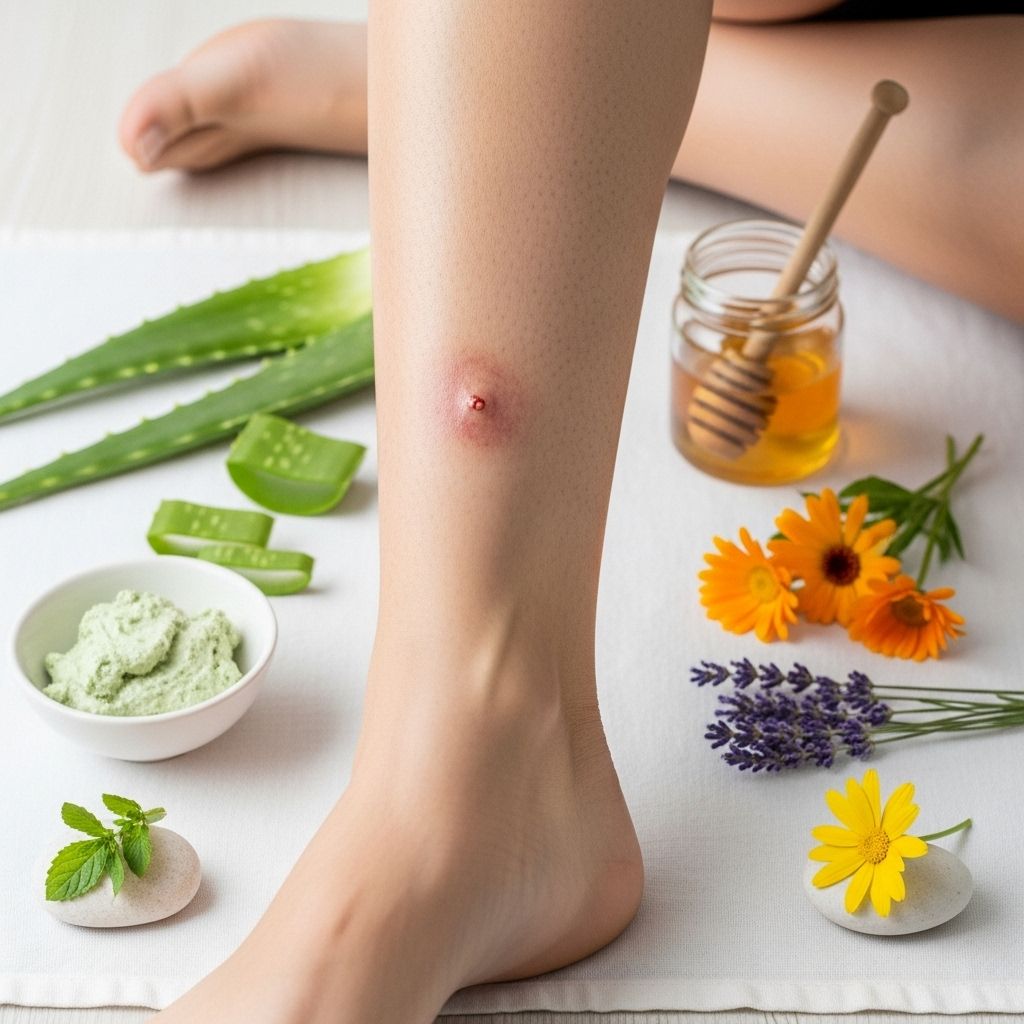How to Treat Leg Ulcers at Home: Effective Natural Remedies
Harness everyday ingredients to calm inflammation and shield wounds for gentle healing.

Understanding Leg Ulcers and Their Causes
Leg ulcers are open wounds that develop on the lower legs and can be both painful and challenging to heal. These persistent sores occur when the skin breaks down due to poor circulation, underlying medical conditions, or external factors. While professional medical treatment is essential for severe cases, various natural home remedies can complement traditional therapy and promote faster healing.
Leg ulcers commonly affect individuals with venous insufficiency, diabetes, peripheral arterial disease, or those who have experienced trauma to the lower extremities. The symptoms typically include persistent open wounds, surrounding skin discoloration, swelling around the ankles, itchy and flaky skin, and hardened skin areas around the ulcer site.
Essential Wound Care Basics Before Home Treatment
Before implementing any home remedies, it’s crucial to establish proper wound care fundamentals. The healing environment plays a significant role in recovery success. Proper cleaning and preparation of the ulcer site creates optimal conditions for natural healing processes to occur.
Begin by gently removing any debris or dead tissue from the ulcer area. Wash the wound thoroughly with clean water and pat dry with sterile gauze. This initial preparation is essential because it removes potential sources of infection and allows home remedies to work more effectively. Always ensure your hands are thoroughly cleaned before touching the affected area.
Top Natural Remedies for Leg Ulcer Treatment
Aloe Vera: Nature’s Healing Gel
Aloe vera stands as one of the most effective natural treatments for leg ulcers due to its remarkable healing properties. This medicinal plant contains powerful compounds including anthraquinones and natural hormones that promote wound healing while preventing bacterial growth and infection.
The gel’s anti-inflammatory properties help reduce swelling and pain around the ulcer site. Its natural antimicrobial action creates a protective barrier against harmful bacteria that could complicate the healing process.
Application Method:
- Make a small incision in a fresh aloe vera leaf
- Extract the clear, jelly-like gel using a clean spoon
- Apply the gel directly to the ulcer surface
- Allow it to air dry naturally
- Repeat this process 2-3 times daily for optimal results
Medical-Grade Honey: Ancient Wound Healer
Honey has been recognized for centuries as a powerful wound healing agent, and modern science confirms its effectiveness for treating leg ulcers. Raw, organic honey possesses exceptional antibacterial and anti-inflammatory properties that accelerate the healing process while reducing pain and swelling.
The high sugar content in honey creates an environment that’s hostile to bacterial growth, while its natural enzymes promote tissue regeneration. Medical-grade manuka honey is particularly effective due to its enhanced antimicrobial properties.
Treatment Process:
- Use only 100% organic, raw honey
- Apply a thin layer directly to the ulcer
- Leave the honey on for 10-15 minutes
- Rinse gently with clean, lukewarm water
- Apply 2-3 times daily consistently
Virgin Coconut Oil: Natural Antimicrobial Treatment
Virgin coconut oil contains powerful fatty acids, particularly lauric acid, which provides excellent antimicrobial properties. This natural oil helps fight bacterial infections while moisturizing the wound area and promoting healthy skin regeneration around the ulcer.
The oil’s medium-chain fatty acids penetrate deep into the skin tissue, delivering healing nutrients directly to the affected area. Its anti-inflammatory properties also help reduce swelling and discomfort associated with leg ulcers.
Application Instructions:
- Use 1-2 tablespoons of high-quality virgin coconut oil
- Gently massage the oil into the ulcer and surrounding skin
- Allow the oil to absorb naturally
- Apply twice daily, morning and evening
Turmeric: Golden Spice with Healing Power
Turmeric contains curcumin, a potent compound with remarkable anti-inflammatory and antimicrobial properties. This golden spice has been used in traditional medicine for wound healing for thousands of years, and its effectiveness for treating leg ulcers is well-documented.
The antioxidants in turmeric help protect healing tissue from free radical damage while promoting healthy blood circulation to the affected area. Its natural antiseptic properties prevent infection and support the body’s natural healing processes.
Preparation and Use:
- Mix 1 teaspoon of high-quality turmeric powder with sufficient water
- Create a thick, paste-like consistency
- Apply the paste evenly over the ulcer
- Allow it to dry completely
- Rinse off with warm water
- For internal support, add turmeric to warm milk and consume daily
Apple Cider Vinegar: Acidic Healing Solution
Apple cider vinegar provides excellent antimicrobial action due to its high acetic acid content. This natural solution also contains beneficial vitamins and minerals that support wound healing and can be particularly effective for treating varicose vein-related ulcers.
The acidic nature of apple cider vinegar helps maintain an optimal pH balance around the wound site, creating an environment that promotes healing while discouraging bacterial growth.
Treatment Method:
- Mix 1 tablespoon apple cider vinegar with 1-2 tablespoons warm water
- Add a small pinch of salt to the solution
- Soak a clean cloth in the mixture
- Place the dampened cloth over the ulcer for 10-15 minutes
- Apply this treatment twice daily
Tea Tree Oil: Powerful Natural Antiseptic
Tea tree oil is renowned for its potent antiseptic and anti-inflammatory properties, making it highly effective for treating persistent leg ulcers. This essential oil has demonstrated significant success in clinical applications for chronic wound care.
The oil’s natural compounds penetrate deep into the wound tissue, fighting infection at the cellular level while promoting healthy tissue regeneration. Its anti-inflammatory action helps reduce pain and swelling around the ulcer site.
Safe Application Guidelines:
- Always dilute tea tree oil before use (10-12 drops in carrier oil)
- Apply the diluted mixture directly to the ulcer
- Use a clean cotton swab for precise application
- Cover with a non-adherent dressing if necessary
- Apply once or twice daily as tolerated
Professional Therapy Techniques You Can Adapt
Medical professionals often employ specialized massage techniques to improve blood circulation around leg ulcers. This approach focuses on restoring active blood supply to the ulcer base, which is essential for proper healing.
The technique involves gentle circular massage of the ulcer center, gradually working toward the firm rim that often surrounds chronic ulcers. This massage helps break down the constricting tissue band that can impede blood flow and healing.
Adapted Home Massage Technique:
- Begin with very gentle circular motions in the center of the ulcer
- Use a suitable lubricant like vegetable oil (after initial healing begins)
- Gradually extend the massage to the surrounding rim
- Perform daily, but stop if pain increases significantly
- Always maintain sterile conditions during the process
Comprehensive Wound Dressing and Protection
Proper wound dressing is crucial for maintaining the healing environment created by natural remedies. The dressing should protect the ulcer from external contamination while allowing air circulation and maintaining appropriate moisture levels.
Choose non-adherent dressings that won’t stick to the healing tissue. Change dressings regularly, typically 1-3 times per week, or as directed by healthcare providers. During dressing changes, assess the wound for signs of improvement or potential complications.
Lifestyle Modifications for Enhanced Healing
Supporting your body’s natural healing processes requires comprehensive lifestyle adjustments. Proper nutrition plays a vital role in wound healing, with adequate protein intake being particularly important for tissue repair and regeneration.
Elevation of the affected leg helps improve circulation and reduce swelling. When sitting or lying down, prop the leg above heart level whenever possible. This simple position change can significantly impact healing speed and comfort levels.
Key lifestyle recommendations:
- Maintain a balanced diet rich in vitamins C and E, zinc, and protein
- Stay adequately hydrated to support cellular healing processes
- Avoid smoking, which impairs circulation and healing
- Engage in gentle, appropriate exercise as recommended by healthcare providers
- Manage underlying conditions like diabetes or hypertension
When to Seek Professional Medical Care
While home remedies can be highly effective, certain situations require immediate professional medical attention. Warning signs include increasing pain, expanding wound size, signs of systemic infection, or failure to show improvement after several weeks of consistent treatment.
Professional healthcare providers can offer advanced treatments such as compression therapy, specialized wound dressings, or surgical interventions when necessary. They can also provide proper diagnosis of underlying conditions contributing to ulcer formation.
Prevention Strategies for Future Occurrences
Preventing future leg ulcers requires ongoing attention to circulation health and skin care. Regular moisturizing of the legs with appropriate oils or lotions helps maintain skin integrity and flexibility.
Early treatment of minor injuries prevents them from developing into larger, more problematic ulcers. Proper foot and leg hygiene, combined with appropriate footwear, reduces trauma risk and supports overall leg health.
Frequently Asked Questions
Q: How long does it typically take for leg ulcers to heal with home remedies?
A: Healing time varies depending on ulcer size and severity, but with consistent treatment, many people see significant improvement within 2-6 weeks. Larger or more chronic ulcers may require several months of dedicated care.
Q: Can I use multiple home remedies simultaneously?
A: Yes, but introduce remedies gradually to monitor for any adverse reactions. It’s often effective to alternate between different treatments throughout the day rather than mixing them together.
Q: Are there any home remedies I should avoid?
A: Avoid using hydrogen peroxide or alcohol directly on open wounds, as these can damage healing tissue. Also avoid remedies that cause increased pain, burning, or irritation.
Q: When should I be concerned about infection?
A: Seek immediate medical attention if you notice increasing redness, warmth, swelling, pus discharge, red streaking, fever, or if the ulcer rapidly increases in size.
Q: Can diet affect leg ulcer healing?
A: Absolutely. A diet rich in protein, vitamins C and E, zinc, and omega-3 fatty acids supports wound healing. Staying well-hydrated is equally important for optimal healing.
References
- https://www.bethaniyaclinic.com/blog/simple-and-effective-home-remedies-to-cure-leg-ulc/
- https://www.aafp.org/pubs/afp/issues/1998/0601/p2628.html
- https://www.nhs.uk/conditions/leg-ulcer/treatment/
- https://www.acceleratecic.com/for-patients/managing-your-leg-ulcer-at-home/
- https://myhealth.alberta.ca/Health/pages/conditions.aspx?hwid=tn8035
- https://www.southvalleyvascular.com/post/leg-ulcers-how-to-relieve-the-pain-at-home
- https://www.betterhealth.vic.gov.au/health/conditionsandtreatments/leg-ulcers
- https://texaseva.com/posts/vein-disease/ulcers-of-the-lower-leg/
- https://pmc.ncbi.nlm.nih.gov/articles/PMC7950104/
Read full bio of medha deb









